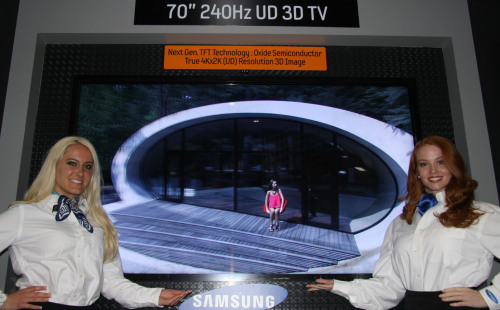
Watching too much 3-D TV could harm kids’ eyes, NBC reported, citing Samsung’s warning which states children and teenagers may be more at risk of having vision problems or seizures if they watch too often.
Ophthamologist Dr. Gregory Haffner said in the interview with NBC that as kids’ eyes are in the developmental stages until age 10 and watching 3-D TV may alter the way their eyes are learning to fuse.
“Theoretically, if they’re watching 3-D television for six or seven hours a day, that is the kind of processing you might get an issue with,” Haffner said.
Another expert pediatric neurologist said the 3-D TVs designed for home use functioned differently than those used in theaters.
“The 3-D technology that is coming out for home use is a little more worrisome for people because it uses this active system which turns on and off, sort of flashes in front of a person’s eyes… the flashing is what’s often provoking for seizures,” said Dr. Cohen.
Dr. Cohen further warns that the active 3-D TV system can be dangerous for people who develop photosensitive epilepsy after surgery to remove a brain tumor.
Regarding the report, Samsung Electronics said the warning sign is included every manual that comes with a 3-D TV and is also offered by every other 3D TV manufacturer. It also explained that the negative side effects are not specifically due to watching active system 3-D TV that Samsung uses for its TV glass, but are common problems when exposed to 3-D TV viewing too much.
By Lee Woo-young (wylee@heraldcorp.com)
<한글 기사>
과도한 3D TV 시청은 눈에 안좋아
美 NBC “삼성전자 3D TV 부작용 야기” 보도
삼성 “가능한 부작용 언급 수준..액티브 방식 문제 아니다”
미국의 3대 공중파 방송인 NBC가 3D TV 시청 위 험성을 경고하고 나섰다.
26일 전자업계에 따르면 NBC는 최근 “삼성전자가 어린이나 청소년이 지나치게 3 D TV를 시청할 경우 시력 문제 또는 간질 발작까지 일으킬 위험이 있다고 경고했다” 는 요지의 보도를 방송했다.
특히 10세 이하 어린이의 경우 시력이 아직 성장 중에 있기 때문에, 지나친 3D TV 시청이 안구 결함을 초래할 수 있는 것으로 전해졌다.
NBC는 이와 관련해 전문가 인터뷰를 인용, “이론적으로 3D TV를 하루 6시간 이 상 시청하면 문제를 야기할 수밖에 없다”며 “특히 극장과 TV에서 사용되는 3D 기술 이 다른 것이 문제”라고 지적했다.
NBC는 “영상이 좌우 교대로 켜지는 액티브 방식의 경우, 사람 눈이 깜박임에 노 출되기 때문에 더 우려스러운 것이 사실”이라며 “이러한 깜박임이 발작증 등 여러 부작용을 일으키는 원인이 된다”고 덧붙였다.
이들은 “뇌종양 수술을 받는 등 특정한 의학적 조건에 놓인 경우 이 같은 부작용에 노출될 가능성이 더욱 크다”며 “액티브 방식 3D TV를 집에서 시청할 경우 불을 켜고, TV 화면과 거리를 충분히 두면 부작용을 최소화할 수 있다”고 조언했다.
삼성전자와 LG전자는 연초 각각 액티브 셔터안경 방식과 필름패턴 편광 안경(FPR) 방식의 3D TV를 출시한 이후, 상대 기술의 단점을 지적하며 신경전을 벌여왔다.
특히 LG전자는 셔터안경 방식의 경우 화면 깜박거림에 따라 어지럼증과 발작 등 부작용이 발생할 수 있다는 점을 주요 공격 지점으로 삼아왔다.
삼성전자는 이에 대해 3D TV를 판매하는 경우 전세계적으로 발행하는 사용 설명 서상의 안전 경고문일 뿐이라고 해명했다.
삼성전자 관계자는 “안전 경고문은 만에 하나의 상황까지 가정해 기술하는 것으로 삼성뿐 아니라 패시브 방식 등 모든 TV 제조업체들이 동일하게 제공하고 있다”며 “언급된 부작용도 액티브 방식 3D 영상을 시청해서 발생하는 문제가 아니라, 3D 영상 자체에 오래 노출되면 발생할 수 있는 문제일 뿐”이라고 말했다.
(연합뉴스)
과도한 3D TV 시청은 눈에 안좋아
美 NBC “삼성전자 3D TV 부작용 야기” 보도
삼성 “가능한 부작용 언급 수준..액티브 방식 문제 아니다”
미국의 3대 공중파 방송인 NBC가 3D TV 시청 위 험성을 경고하고 나섰다.
26일 전자업계에 따르면 NBC는 최근 “삼성전자가 어린이나 청소년이 지나치게 3 D TV를 시청할 경우 시력 문제 또는 간질 발작까지 일으킬 위험이 있다고 경고했다” 는 요지의 보도를 방송했다.
특히 10세 이하 어린이의 경우 시력이 아직 성장 중에 있기 때문에, 지나친 3D TV 시청이 안구 결함을 초래할 수 있는 것으로 전해졌다.
NBC는 이와 관련해 전문가 인터뷰를 인용, “이론적으로 3D TV를 하루 6시간 이 상 시청하면 문제를 야기할 수밖에 없다”며 “특히 극장과 TV에서 사용되는 3D 기술 이 다른 것이 문제”라고 지적했다.
NBC는 “영상이 좌우 교대로 켜지는 액티브 방식의 경우, 사람 눈이 깜박임에 노 출되기 때문에 더 우려스러운 것이 사실”이라며 “이러한 깜박임이 발작증 등 여러 부작용을 일으키는 원인이 된다”고 덧붙였다.
이들은 “뇌종양 수술을 받는 등 특정한 의학적 조건에 놓인 경우 이 같은 부작용에 노출될 가능성이 더욱 크다”며 “액티브 방식 3D TV를 집에서 시청할 경우 불을 켜고, TV 화면과 거리를 충분히 두면 부작용을 최소화할 수 있다”고 조언했다.
삼성전자와 LG전자는 연초 각각 액티브 셔터안경 방식과 필름패턴 편광 안경(FPR) 방식의 3D TV를 출시한 이후, 상대 기술의 단점을 지적하며 신경전을 벌여왔다.
특히 LG전자는 셔터안경 방식의 경우 화면 깜박거림에 따라 어지럼증과 발작 등 부작용이 발생할 수 있다는 점을 주요 공격 지점으로 삼아왔다.
삼성전자는 이에 대해 3D TV를 판매하는 경우 전세계적으로 발행하는 사용 설명 서상의 안전 경고문일 뿐이라고 해명했다.
삼성전자 관계자는 “안전 경고문은 만에 하나의 상황까지 가정해 기술하는 것으로 삼성뿐 아니라 패시브 방식 등 모든 TV 제조업체들이 동일하게 제공하고 있다”며 “언급된 부작용도 액티브 방식 3D 영상을 시청해서 발생하는 문제가 아니라, 3D 영상 자체에 오래 노출되면 발생할 수 있는 문제일 뿐”이라고 말했다.
(연합뉴스)








![[KH Explains] How should Korea adjust its trade defenses against Chinese EVs?](http://res.heraldm.com/phpwas/restmb_idxmake.php?idx=644&simg=/content/image/2024/04/15/20240415050562_0.jpg&u=20240415144419)










![[Today’s K-pop] Stray Kids to return soon: report](http://res.heraldm.com/phpwas/restmb_idxmake.php?idx=642&simg=/content/image/2024/04/16/20240416050713_0.jpg&u=)